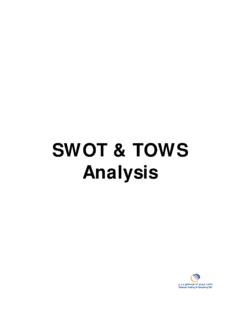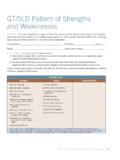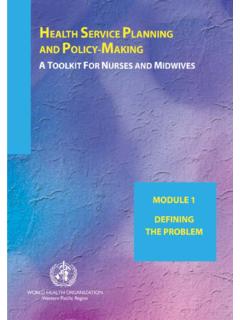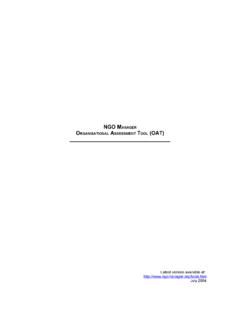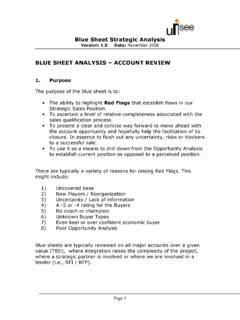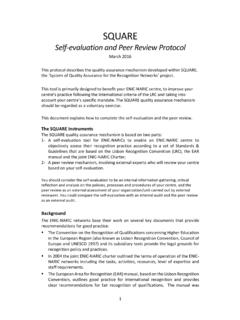Transcription of How to Play to Your Strengths - missionimprovement1.com
1 How to Play to your Strengths by Laura Morgan Roberts, Gretchen Spreitzer, Jane Dutton, Robert Quinn, Emily Heaphy, and Brianna Barker Yo u m ay have more to gain by developing your gifts and leveraging your natural skills than by trying to repair your weaknesses. Here is a systematic way to discover who you are at your very best. Reprint R0501G How to Play to your Strengths by Laura Morgan Roberts, Gretchen Spreitzer, Jane Dutton, Robert Quinn, Emily Heaphy, and Brianna Barker harvard business review managing yourself january 2005page 1 COPYRIGHT 2004 HARVARD BUSINESS SCHOOL PUBLISHING CORPORATION. ALL RIGHTS RESERVED. Yo u m ay have more to gain by developing your gifts and leveraging your natural skills than by trying to repair your weaknesses.
2 Here is a systematic way to discover who you are at your very best. Most feedback accentuates the negative. Dur-ing formal employee evaluations, discussionsinvariably focus on opportunities for im-provement, even if the overall evaluation islaudatory. Informally, the sting of criticismlasts longer than the balm of praise. Multiplestudies have shown that people pay keen at-tention to negative information. For example,when asked to recall important emotionalevents, people remember four negative mem-ories for every positive one. No wonder mostexecutives give and receive performance re-views with all the enthusiasm of a child on theway to the , corrective feedback has itsplace, of course; every organization must filterout failing employees and ensure that every-one performs at an expected level of compe-tence.
3 Unfortunately, feedback that ferrets outflaws can lead otherwise talented managers tooverinvest in shoring up or papering over theirperceived weaknesses, or forcing themselvesonto an ill-fitting template. Ironically, such afocus on problem areas prevents companiesfrom reaping the best performance from itspeople. After all, it s a rare baseball player whois equally good at every position. Why should anatural third baseman labor to develop hisskills as a right fielder?The alternative, as the Gallup Organizationresearchers Marcus Buckingham, Donald Clif-ton, and others have suggested, is to foster ex-cellence in the third baseman by identifyingand harnessing his unique Strengths .
4 It is a par-adox of human psychology that while peopleremember criticism, they respond to former makes them defensive and there-fore unlikely to change, while the latter pro-duces confidence and the desire to perform bet-ter. Managers who build up their Strengths canreach their highest potential. This positive ap-proach does not pretend to ignore or deny theproblems that traditional feedback mecha-nisms identify. Rather, it offers a separate andunique feedback experience that counterbal-ances negative input. It allows managers to tapinto Strengths they may or may not be aware ofand so contribute more to their organizations.
5 How to Play to your Strengths harvard business review managing yourself january 2005page 2 Laura Morgan Roberts is an assistant professor of organizational behavior at Harvard Business School in Boston. Gretchen Spreitzer Jane Dutton Robert Quinn are professors of management and or-ganization at the Stephen M. Ross School of Business at the University of Michigan in Ann Arbor. Emily Heaphy is a PhD candi-date in management and organization at the Ross School of Business, and Brianna Barker is a PhD candidate in organiza-tional psychology at the University of Michigan. During the past few years, we have devel-oped a powerful tool to help people under-stand and leverage their individual the Reflected Best Self (RBS) exercise,our method allows managers to develop asense of their personal best in order to in-crease their future potential.
6 The RBS exerciseis but one example of new approaches spring-ing from an area of research called positive or-ganizational scholarship (POS). Just as psychol-ogists know that people respond better topraise than to criticism, organizational behav-ior scholars are finding that when companiesfocus on positive attributes such as resilienceand trust, they can reap impressive bottom-linereturns. (For more on this research, see thesidebar The Positive Organization. ) Thou-sands of executives, as well as tomorrow s lead-ers enrolled in business schools around theworld, have completed the RBS this article, we will walk you throughthe RBS exercise step-by-step and describethe insights and results it can yield.
7 Before weproceed, however, a few caveats are in , understand that the tool is not designedto stroke your ego; its purpose is to assist youin developing a plan for more effective action.(Without such a plan, you ll keep running inplace.) Second, the lessons generated fromthe RBS exercise can elude you if you don tpay sincere attention to them. If you are tooburdened by time pressures and job demands,you may just file the information away andforget about it. To be effective, the exercise re-quires commitment, diligence, and follow-through. It may even be helpful to have acoach keep you on task. Third, it s importantto conduct the RBS exercise at a differenttime of year than the traditional performancereview so that negative feedback from tradi-tional mechanisms doesn t interfere with theresults of the correctly, the RBS exercise can helpyou tap into unrecognized and unexploredareas of potential.
8 Armed with a constructive,systematic process for gathering and analyzingdata about your best self, you can burnish yourperformance at work. Step 1 Identify Respondents and Ask for Feedback The first task in the exercise is to collect feed-back from a variety of people inside and out-side work. By gathering input from a variety ofsources family members, past and presentcolleagues, friends, teachers, and so on youcan develop a much broader and richer under-standing of yourself than you can from a stan-dard performance we describe the process of the ReflectedBest Self exercise, we will highlight the experi-ence of Robert Duggan (not his real name),whose self-discovery process is typical of themanagers we ve observed.
9 Having retired froma successful career in the military at a fairlyyoung age and earned an MBA from a topbusiness school, Robert accepted a midlevelmanagement position at an IT services strong credentials and leadership expe-rience, Robert remained stuck in the same po-sition year after year. His performance evalua-tions were generally good but not strongenough to put him on the high-potential , frustrated, and disheartened, Rob-ert grew increasingly stressed and disillusionedwith his company. His workday felt more andmore like an episode of Survivor .Seeking to improve his performance, Rob-ert enrolled in an executive education programand took the RBS exercise.
10 As part of the exer-cise, Robert gathered feedback from 11 individ-uals from his past and present who knew himwell. He selected a diverse but balancedgroup his wife and two other family mem-bers, two friends from his MBA program, twocolleagues from his time in the army, and fourcurrent then asked these individuals to pro-vide information about his Strengths , accom-panied by specific examples of momentswhen Robert used those Strengths in waysthat were meaningful to them, to their fami-lies or teams, or to their organizations. Manypeople Robert among them feel uncom-fortable asking for exclusively positive feed-back, particularly from colleagues.

